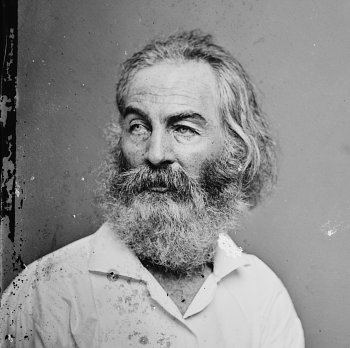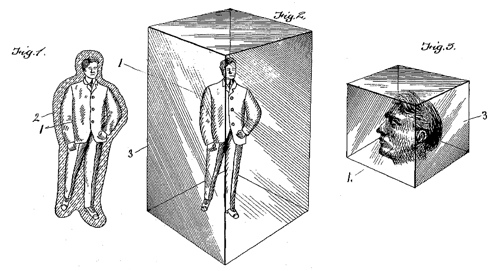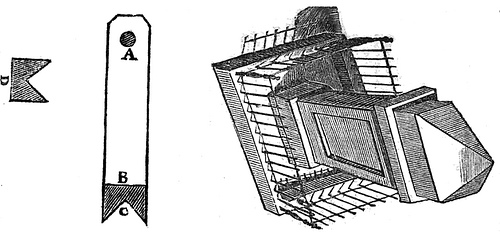
“Walt Whitman is as unacquainted with art as a hog is with mathematics.” — London Critic, 1855

“Walt Whitman is as unacquainted with art as a hog is with mathematics.” — London Critic, 1855
Prospicimus modo quod durabunt faedera longo
Tempore, nec nobis pax cito diffugiet.
That means “We foresee now that the confederacy shall last a long time, and that peace will not quickly fly away from us.” But reverse it:
Diffugiet cito pax nobis, nec tempore longo
Faedera durabunt, quod modo prospicimus.
and it means “Peace will soon fly away from us, and the covenant shall not last long, which we foresee already.”
See also A Bilingual Palindrome.

Once Zhuangzi dreamt he was a butterfly, a butterfly flitting and fluttering around, happy with himself and doing as he pleased. He didn’t know he was Zhuangzi. Suddenly he woke up and there he was, solid and unmistakable Zhuangzi. But he didn’t know if he was Zhuangzi who had dreamt he was a butterfly, or a butterfly dreaming he was Zhuangzi. Between Zhuangzi and a butterfly there must be some distinction! This is called the Transformation of Things.
— Zhuangzi, Chinese text, fourth century B.C.
In 1776 an unfortunate woman was found sheltering under a haystack in Bourton, near Bristol. By day she would seek charity from the local people, but at night she would always return to the haystack, saying only that “trouble and misery dwelt in houses.”
Curiously, she appeared well bred and accustomed to good society. Hannah More, who took up her cause, found her “handsome, young, interesting, enough Mistress of her reason carefully to shut up from our observation every avenue that might lead to her secret.”
More published “A Tale of Real Woe” in the St. James’s Chronicle in 1785, offering what little she had been able to learn about the woman: “that her Father was a German, her Mother an Italian; that she has one brother and one Sister; that her father had a very fine garden full of olive and orange Trees.”
Rumors abounded that “Louisa” was an illegitimate daughter of Francis I, emperor of Austria, and thus a half-sister to Marie Antoinette, but these have never been substantiated. Whoever she was, the woman spent the next 16 years in a succession of hospitals, never giving her identity, and when she died in 1801, she took her secret with her.
The Earl of Yarborough offers you a wager. He’ll shuffle an ordinary deck and deal you 13 cards. If none of your cards ranks above 9, he’ll give you a thousand pounds. Otherwise you must give him one pound.
Should you accept?

Thanks to Joseph Karwowski, you’ll never have to say goodbye to your Uncle Julius. Patented in 1903, Karwowski’s “method of preserving the dead” hermetically encases the corpse in a block of transparent glass to prevent decay and maintain a lifelike appearance.
Bonus: “In Fig. 3 I have shown the head only of the corpse as incased within the transparent block of glass, it being at once evident that the head alone may be preserved in this manner, if preferred.”
LIST and ROLL are synonyms in two different senses.
Both mean to tilt — and both refer to a series of names.
onymous
adj. not anonymous

This clever anamorphic illusion was invented by W. Shires in 1821. Cut out the center piece, make a hole at A, fold it at B, and position it at D. (Here’s a larger version.)
Peer through the hole with one eye, preferably with a light source on your right, and you’ll see the tombstone in three dimensions, surrounded by a low palisade.
Here’s another scene using the same principle; position the eyepiece where the turrets’ lines would converge and “the whole view will appear in its just proportions, representing a castle at a considerable distance, the loftiest part of which appearing scarcely an inch high.”
William Lawson, teacher of mathematics in Edinburgh, who died in 1757, when employed about twenty years before his death as preceptor to the sons of a gentleman, was induced by his employer to undertake an extraordinary piece of mental calculation. Upon a wager laid by his patron, that the numbers from 1 to 40 inclusive could, by memory alone, be multiplied continually–that is, 1 multiplied 2; the product then arising, 2, by 3; the next product, 6, by 4; the next, 24, by 5; and so on, 40 being the last multiplier–Mr. Lawson was, with reluctance, prevailed upon to attempt the task. He began it next morning at seven o’clock, taught his pupils their Latin lessons in the forenoon as usual, had finished the operation by six in the evening, and then told the last product to the gentlemen who had laid the wager; which they took down in writing, making a line of forty-eight figures, and found to be just. … When the operation was over, he could perceive his veins to start, like a man in a nervous fever; the three following nights he dreamed constantly of numbers; and he was often heard to say that no inducement would ever again engage him in a like attempt. A fair copy of the whole operation, attested by the subscriptions of three gentlemen, parties in the wager, was put into a frame with glass, and hung up in the patron’s dining-room.
— Chambers’s Journal, Sept. 27, 1856